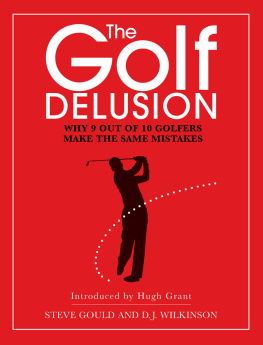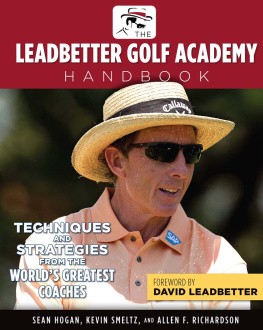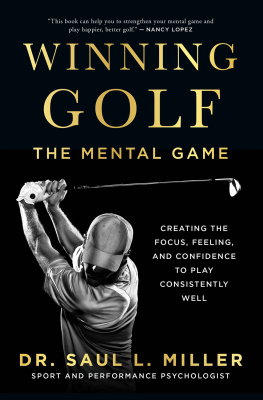The Three Principles
of Outstanding Golf
How A Golfers Mind Really Works.
by Sam Jarman
Copyright Sam Jarman
First Published March 2016 by Sam Jarman
Smashwords Edition
This book remains the copyrighted property of the author, and may not be redistributed to others for commercial or non-commercial purposes. If you enjoyed this book, please encourage your friends to purchase their own copy from their favourite retailer.
Thank you for your support.
A catalogue record for this book is available from the British Library
ePub ISBN: 978-0-9935734-2-2
Cover image by Matt Gibson, distributed by Shutterstock.com
Any information offered in this book should not be treated as a substitute for professional medical advice. Any use of the information in this book is at the readers discretion and risk. The author cannot be held responsible for any loss, claim or damage arising out of the use, or misuse of the information in this book, or for any material on third party websites.
Table of Contents
Acknowledgements
There are a number of people without whom you would not be reading these words.
Jamie Smart and Garret Kramer, who between them opened my eyes to a new way of seeing the world, and a new way of playing the game I had fallen in and out of love with over the past thirty years.
Elsie Spittle, for her recollections of her friendship with Syd Banks, and her kind words of encouragement.
Alistair Tait, who edited the book, tightened and brightened my paragraphs, activated my passive sentences and specified my non specific pronouns.
Julia Jarman, a far better writer than I will ever be. Her love of books and the written word was a constant theme throughout my childhood, and was clearly more of an inspiration than I realised at the time.
My girlfriend Fenella, for her love and support, proof reading skills and the very welcome supply of coffee and the occasional beer.
Mike Snapes, Andy Pollock, Adam Jerreat, Gerry Kennedy and numerous others who offered comments, feedback and encouragement during the writing process.
David Cowap for his help with the cover design and typesetting.
My friends, lesson clients and fellow golfers at Woburn and elsewhere, for your friendship, feedback, support and companionship on and off the golf course. I have learnt at least as much from you as you have from me. Hopefully it has made us all better golfers, and will continue to do so.
Lastly to Sydney Banks, who saw what he saw, and wasnt afraid to tell the world about it.
Foreword
It is rare these days that I come across a golf coaching book which holds my attention from start to finish. It is also rare to find a book about the mind written by someone who is genuinely at the coal face of both playing and coaching as opposed to classroom theory. Sam has written such a book.
It will do what a great book should by challenging your existing beliefs and making you think about the way you either play or coach the game. It is not more of the same positive thinking and affirmation nonsense but a genuine inquiry about how our mind actually interacts with our body to either make or break our performance. Your game and your life cant help but be enhanced by reading this book.
Dr Karl Morris
If the only thing people learned was not to be afraid of their experience, that alone would change the world.
Syd Banks
CHAPTER 1
We Dont Do Head Stuff.
Golf is deceptively simple and endlessly complicated; it satisfies the soul and frustrates the intellect. It is at the same time rewarding and maddening and without a doubt the greatest game mankind has ever invented.
Arnold Palmer
It was the Sunday afternoon of the 2011 Players Championship at TPC Sawgrass in Florida. Cheers rang out as KJ Choi and David Toms battled for the title over the closing holes. Things were a little quieter on the front nine, and a lot less dramatic. Bad weather on Saturday meant the third round had been completed on Sunday morning. The Tour implemented a two tee start to finish the final round on schedule on Sunday evening. Players further down the field were on the golf course at the same time as the leaders.
I was watching Ian Poulter. I knew Ian from playing mini tour events years ago, and through his attachment to Woburn Golf Club. Also walking with the three ball were his wife Katie, IJP Design colleague Russell Hurd and fellow Woburn members Gary Johnstone and Steve Jensen.
Playing the back nine first, he was hitting the ball nicely but not holing anything. Very relaxed, he was chatting with his caddy Terry Mundy and exchanging some banter with Russell. We watched him hit his tee shot down the 1st. Gary, Steve and I waited to see Bubba Watson drive off in the group behind before walking across to the 2nd green to meet Ians group as they came down the par five.
Things didnt go well. The hole is reachable in two shots and a definite birdie opportunity. Ian blocked his drive right into the trees. He found his ball, but hit a tree with his recovery shot and had to take a penalty drop. He hacked it out and laid up sixty yards short of the green. In typical, never give up Poulter fashion, he pitched to six inches for a double bogey seven.
Looking a bit disenchanted with life, he tapped in, then wandered to the back of the green and sat down in an empty marshalls seat while his two playing partners putted out. I watched from about twenty yards away as he pulled the yardage book out of his back pocket and started scribbling, intent on getting something important down on paper. Always curious about what top players are thinking, I wondered what he was writing.
The double bogey had little effect on him. He made one of the best up and downs I have ever seen on the next hole to save par.
A few weeks later, I was back at Woburn watching the English Amateur Championship being played over the Marquess course. A couple of players I worked with were competing, so I spent the morning wandering in the sunshine watching them play. As I walked back to the clubhouse, I spotted two familiar figures on the practice ground alongside the eighteenth fairway. I made my way over to find Ian and caddy Terry in animated discussion about how to use a new video camera.
Alright if I watch you hit a few? I asked, after we had exchanged pleasantries.
Youre fine mate, Ian replied.
I stretched out on the grass as he fired six irons onto one of the tiny practice greens halfway down the range.
After an hour it became clear he was winding down. The conversation with Terry moved on from business (his golf swing) to football, cars, recent tournaments, typical golfer chit chat. I waited for a lull in the conversation, took a deep breath, then dived in.
Ian, Im not sure I should ask, but do you remember the second hole at Sawgrass on Sunday? You hit it into the trees off the tee but couldnt get it back on the fairway. Then you laid it up and pitched it stiff from about sixty yards. I think you made a double?
He looked at me quizzically for a couple of seconds. Err, vaguely. Why?
You sat down at the back of the green and wrote stuff in your yardage book for about five minutes. It looked pretty important at the time. Can I ask you what you were doing?
Probably just writing down my yardages and doing the scorecard.
So you werent making notes or anything?
Notes? What about?
Well, youd just made a mistake, and seemed a bit annoyed about it. I wondered if you were writing some notes. You know, positive mental reminders, key swing thoughts, some affirmations maybeyou know, Head Stuff?










